Bugs of the desert spend almost all of their lives in the ground. They may also be fully nocturnal which may make it seem like there are no species in deserts.
From the deserts of North America to The Saharan Desert, thousands of bugs make their living here.
Only adaptable species can survive arid desert climates. Here’s how they do it.
Table of Contents
Desert Bug Adaptations
The deserts of the world can get quite hot. At high temperatures, most bugs tend to die but some can still live even in the hottest deserts.
Birds are among the most common predators of bugs in the desert. On the ground, bugs face predators such as snakes.
Unlike birds, snakes often surprise them in the rodent burrows they live in.
Scorpions and large spiders are among the common species of predators that also eat bugs. Many venomous species even paralyze bugs to eat them later.
Living in burrows
Digging their burrows (digger bees) or using the burrows of other species (ticks), bugs in the desert first try to get themselves out of the sun and into the ground.
Temperatures are considerably cooler a few inches below the ground.
Living under rocks
Seeking out a shaded place under rocks and vegetation is also common for bugs of the desert. Species such as centipedes rarely venture out of these shaded places themselves.
Becoming nocturnal
Bugs that only come out at night are bugs that face considerably lower temperatures.
Some bugs only come out at night to avoid predators which easily spot them during the day.
Only coming out a few minutes per day
Sahara Desert Ants and other ants are among the species that only come out up to 10 minutes per day.
Even within minutes, they keep on moving to avoid getting fried in the sun.
Eating plants, fruits, and other bugs
Bugs can still find plants such as cacti to feed on in deserts. They can also eat other bugs, pollen, feces, and even other dead bugs.
The most adaptable species always live in wider habitats as opposed to the species that only eat a certain type of food such as a type of cacti.
Some bugs have a long pupation time
Bugs can also survive the winters in the desert by spending them in the larval stage. They only pupate in the spring or as soon as the first rain arrives in the rainy season.
Bugs in the Desert
Here are some of the common and rare bugs of the desert found across the world.
1. Desert Hairy Scorpion

This type of yellow scorpion (Hadrurus arizonensis) shows short brown hairs across its body. As a yellow scorpion, the brown dorsum helps it improve camouflage.
Desert Hairy Scorpions are a species of The Mojave and The Sonoran Desert.
A species rarely seen due to its burrowing habits, the scorpion rarely interacts with humans.
It does have a venomous and mildly painful sting which is not lethal in most cases unless there’s a type of allergic reaction to its sting.
This is a species that uses its venom mostly against small prey such as bugs and insects.
Larger prey proves easier to handle once immobilized with its venom. A common example of large prey Desert Hairy Scorpions immobilize includes Giant Centipedes, often larger than these scorpions.
2. Desert Tarantula

Desert Tarantulas (Aphonopelma iodius) are natives of the Southwestern North American deserts.
They reach a maximum size of 5 inches and are identified by tan, brown, and black coloring.
Like other species, they live in burrows where they escape the high desert heat.
Desert Tarantulas are known for using the burrows they already find in the desert which they line the entrances with silk.
This silk is what allows them to detect bugs and insects early and catch them before they escape.
The Desert Tarantula is both diurnal and nocturnal.
It rests at the base of the burrows where its connected silk thread signals the vibrations prey is trapped.
Desert Tarantulas also get out of the burrow to look for food, typically at night.
3. Sonoran Desert Centipede

Native to the desert, The Sonoran Desert Centipede (Scolopendra polymorpha) survives here by eating insects, lizards, and frogs.
Always preferring high moisture habitats, the centipede prefers to live in shaded places where it can survive several years.
A typical centipede grows to a size between 4-5 inches and has a brown color with a black head and bright yellow legs along its body.
These types of centipedes are known to be highly aggressive. This is best seen during the breeding process when either the male or the female is killed by the breeding partner.
4. Desert Millipede

Living underground, Desert Millipedes (Orthoporus ornatus) are a long-living species of the desert.
Surviving up to 10 years, these millipedes have adapted to moisture and self-defense against common predators.
Apart from living in the ground, Desert Millipedes can also curl into a ball, a trait that allows them to escape imminent threats.
These brown types of millipedes survive on bacteria and whatever plants they can find underground.
Areas with damp soils such as those covered in rocks are among the ideal places for these millipedes and their food.
5. Desert Recluse

One of the venomous spiders of the desert, The Desert Recluse (Loxosceles deserta) can bite humans.
The effects of its bite can last for weeks and can manifest as dark skin, swollen skin, and painful skin in the area of the bite.
While the effects of the bite can last a long time, actual bites are rare. Desert Recluses aren’t fans of living in homes and they are mostly found in deserts.
It’s here they can feed on the various local species and hide from the sun in the ground.
Desert Recluses are found in different burrows such as those of squirrels or rodents.
6. Desert Whitetail

Various pools of the desert can be all the water that’s needed for some species to survive and breed.
This is the case of The Desert Whitetail (Plathemis subornata), a species that only lives next to these pools.
It’s here that the dragonfly can feed and breed. Some of its favorite foods include mosquitoes and their eggs.
This species of dragonflies is dominated by a blue nuance body, white-blue, transparent, and black wings.
It also has large blue and white eyes which they rely on to spot insects that pass by.
Desert whitetails are a type of ambush predator as they don’t move about for food.
7. Desert Shadowdamsel

A banded appearance is characteristic of The Desert Shadowdamsel (Palaemnema domina).
This is a dragonfly with bright blue bands across its abdomen, black sections, and bright blue sections. Its thorax is mostly black and blue.
Bright blue sand-like legs are specific to the dragonfly.
Desert Shadowdamsels have mostly transparent wings with black veins and black margins.
Dragonflies of the species tend to live next to vegetation and the rare water sources of the desert which includes the occasional sycamore.
Like other species of dragonflies, Desert Shadowdamsel flies in tandem for long periods while breeding.
8. Desert Stink Beetles

Mostly black, The Desert Stink Beetle (genus Eleodes) is a species named after its stinky sprays.
While the beetle can be black in most cases, it can also be brown, showing a high degree of coloring variability depending on its region.
The smoothness of its elytra is also variable, according to its region. Some Desert Stink Beetles can have ridges on the elytra or can have smooth elytra.
This is also a beetle known to raise its rear end and use it to direct a type of secreted chemical to keep predators away.
Beetles of this genus live in the ground in the desert and are also a species of other habitats such as grasslands.
These beetles are typically found around one of the 3 species of mesquite of The Sonoran Desert.
9. Desert Ironclad Beetle

The bright blue coloring is specific to the elytra of The Desert Ironclad Beetle (Asbolus verrucosus).
This species of bugs that stand out is native to the deserts of The Southwestern United States.
Reaching a size of almost 1 inch, the bugs are further identified by their black spots or warts on the elytra.
They show adaptations to the desert habitat such as having an omnivorous diet as they can even eat dead insects.
Apart from bugs and insects, they can also eat living or dead plants, including whatever fruit they can find.
Desert Ironclad Beetles can also fool or try to fool predators by playing dead.
10. Solifuges

Present in all deserts around the world, including those in the Southwestern US, Solifuges grow to a size of up to 6 inches.
These types of arachnids are falsely known as spiders, but they can also be known as Wind Scorpions locally.
Living in arid conditions, they have a varied diet which is more complex than the diet of a spider mainly through their size.
Some of their foods even include young snakes, spiders, or small scorpions.
Ants and termites are a more common food as they’re easier to catch. Solifuges can eat almost anything they can find and overpower the ground.
Subject to various myths, solifuges can still bite humans. Their long mandibles mean these bites are always painful.
11. Desert Cockroach

Some cockroaches also live in the desert. Mostly invisible because of their underground living preferences, Desert Cockroaches (Arenivaga investigata) these dark roaches grow to 0.5 inches.
Desert Cockroaches are nocturnal, only coming out of the ground at night.
Females are flightless and they initiate breeding. Males can fly and typically respond to the chemical cues of females for breeding at night.
These types of roaches spend their days in the ground. They prefer the burrows of rodents as these are the places where fungi they eat are found in high amounts.
While both males and females live in the sand during the day, these types of bugs get all the moisture they need from the air.
12. Desert Locust

Yellow and black, Desert Locusts (Schistocerca gregaria) may show high variability in colors, size, and habits as one of the most adaptable species of these arid habitats.
These types of locusts can live on their own or swarm in very large numbers.
Desert Locust swarming is one of the biggest agricultural challenges to many areas of the world around deserts.
In some years, this locust may not invade fields while in others, they can do it in their millions.
While biopesticides are often used against these locusts, they can easily eliminate all types of plants left in a desert area that gets no preventive measures.
These locusts can eat all types of vegetation and typically cause vast economic loss on crops.
13. Cactus Bee

There aren’t too many flowering plants to support bees in the desert.
However, Cactus Bees (Diadasia rinconis) are among the species that can live even with a limited number of plants around them.
These bees feed on the flowering cacti of the desert as well as on other types of flowers that may be found here, including some types of asters.
Nesting on the ground, these bees don’t live solitary lives, preferring to live in small groups.
Peak activity is specific to the periods of the summer when the flowers they visit are in bloom.
14. Pallid Desert-Digger
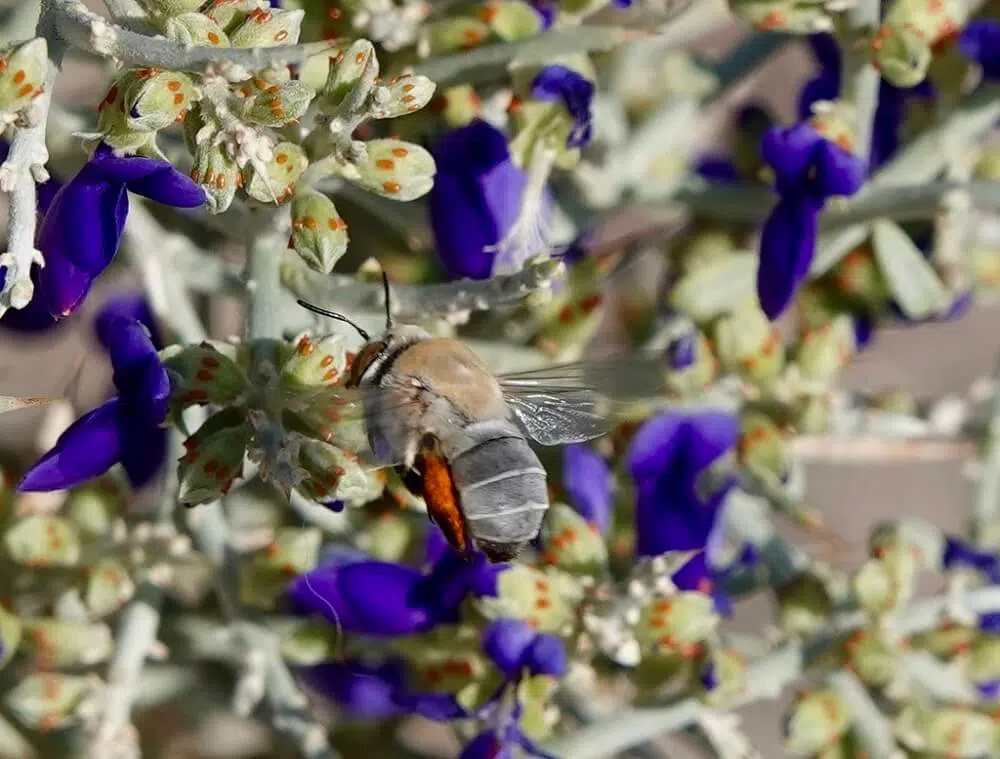
One of the most important bees in the Southwestern US deserts, The Pallid Desert-Digger (Centris pallida) is among the species of bees that can survive hot temperatures.
They play an important role in the pollination of whatever local plants can be found in the desert.
While also spotted on various cacti, The Pallid Desert-Digger is a species that’s mostly associated with palo verde.
It also feeds pollen and nectar from the species to your offspring.
These digger bees dig nests in the ground where an egg is laid, together with palo verde pollen and nectar.
While the amount of provisioning for the emerging bees varies, the sheltered underground burrows of new bees mean they have few natural predators in their early days.
15. Saharan Sandlouse

A species common in deserts of the world such as The Negev Desert, The Saharan Sandlouse (Hemilepistus reaumurii) is a species of gray-blue bug that grow to a maximum size of up to 1 inch.
This is a bug that draws moisture from the atmosphere and from the plants it consumes.
Living in its thousands in the sands of the desert, the bug can also draw moisture from the ground.
Saharan Sandlouses are also known to eat sand. As an extreme measure, these bugs can ingest humid sand for water.
To reach the damp sand substrate, The Saharan Sandlouse can burrow down to 20 inches.
The bugs are also a common type of prey for the various predators of the desert, including scorpions.
16. Sahara Desert Ant

The Saharan Desert Ant (Cataglyphis bicolor) is one of the few ants and animals that live in The Saharan Desert.
This large desert that borders The Red Sea and The Atlantic Ocean is hot and requires some adaptations on their part.
For example, Saharan Desert Ants are always on the move when walking on sand to further cool off.
Even by doing so, The Saharan Desert Ant is only out on the sand for a few minutes per day.
A trait shared with other ants of the desert such as The Saharan Silver Ant, The Sahara Desert Ant only comes out for food for very brief periods to avoid dying from overheating.
17. Namib Desert Dune Ant

The Namib Desert (Camponotus detritus) is home to these species of nesting ants.
Living under the role of a queen, The Namib Desert Dune Ant nests in the ground, where temperatures are considerably cooler.
Ants of this species are easy to identify based on their banded abdomens as they aren’t uniformly colored as other ant species.
A black and white abdomen is specific to The Namib Desert Dune Ant.
Spending a lot less time outdoors than other ants, this is a species that mostly feeds on live or dead insects.
Scale insects found on plants are among its favorite easy prey.
Ants of the species are also important prey for other local wildlife such as Buckspoor Spiders.
18. California Patch

Found in deserts and canyons of the Southern United States, California Patch (Chlosyne californica) are butterflies found next to Shrubby goldeneye.
While common in California, the butterfly’s range expands into Mexico and Baja California.
It also feeds on sunflowers and similar species found in arid climates, sometimes resembling their colors.
A combination of brown and yellow-orange nuances is specific to its wings.
This species has a V-shaped bright pattern across its forewings and hindwings.
Similar colors and patterns of brighter nuances are also seen on its underwings.
Some of the best times to spot this butterfly is immediately after it rains as this is the period when The Shrubby goldeye blooms.
19. Desert Orange Tip

Desert Orange Tip butterflies (Colotis evagore) have a bright appearance with orange marks on the forewings.
The bright appearance of the species is characteristic both to its males and females.
Like other species, these butterflies are found around flowering species in the periods they flower in.
Some of their most common food sources and hosts for their eggs include plants in the mustard family.
These wildflowers are also used by females to lay eggs on.
Butterflies of this species are found on the remote territory of Santa Catalina Island in California, an arid territory they share with other resourceful species such as The Santa Catalina Island Desert Iguana.
20. Desert-Marigold Moth

Desert-Marigold Moths (Schinia miniana) are native to the deserts between US and Mexico.
It’s here they feed on asters such as the all-yellow desert marigold.
The influence of this plant on Desert-Marigold Moths expands beyond feeding as this is a species of bright moths.
A mostly yellow nuance with pink patterns is specific to The Desert-Marigold Moth.
The moth can also be mostly yellow and white, with pink patterns only visible on its hindwings.
Native to US and Mexico areas, Desert-Marigold Moths are seen in the spring and in the fall, the periods when these flowers are in bloom.
21. Common Flower Moth
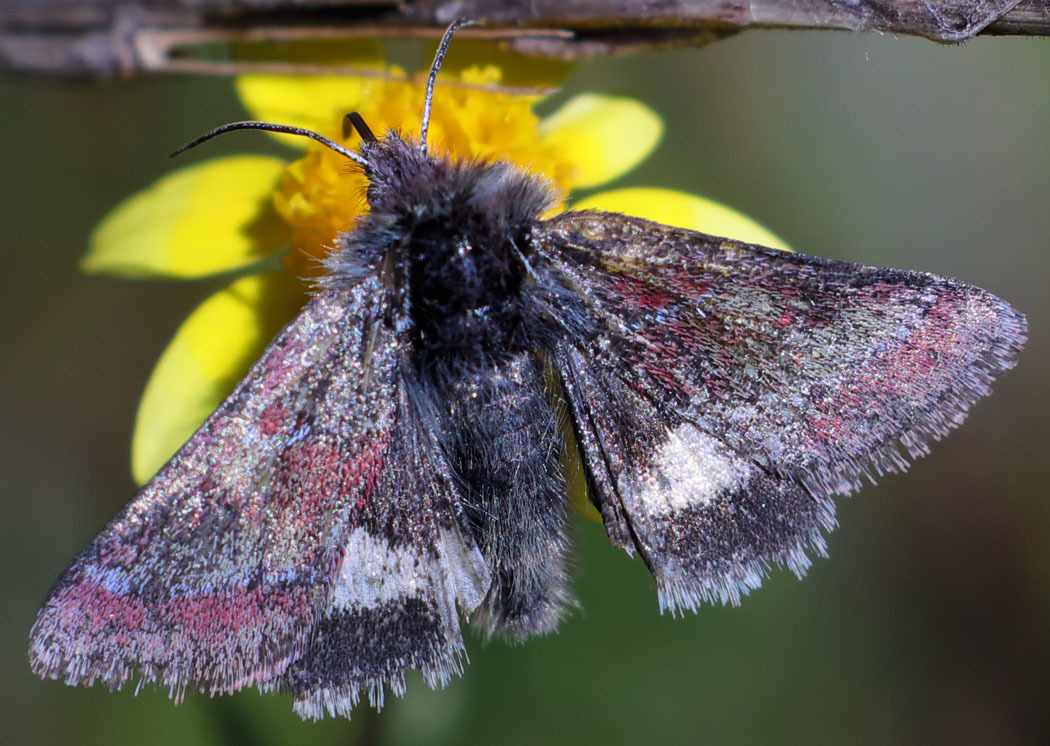
The Common Flower Moth (Schinia pulchripennis) is a purple moth of The Mojave Desert.
Black and white nuances are specific to its wings which additionally show purple overlays.
Some of its purple coloring can be explained by the host of its caterpillars, purple owl’s clover.
The Common Flower Moth visits different types of wildflowers in the desert and California.
Caterpillars of the species burrow when reaching their maximum growth stage.
Pupation is often delayed until the first rain which triggers the emergence of the purple moth.
22. Western Horse Lubber Grasshopper

One of the largest bugs of the desert, The Western Horse Lubber Grasshopper (Taeniopoda eques) is a species endemic to The Sonoran Desert.
Some confusion in identifying this species can happen due to its variable coloring.
Mostly black and yellow in The United States, The Western Horse Lubber Grasshopper can also be mostly yellow in its Mexican territories.
Mostly feeding on plants, the grasshopper can also feed on dead insects and their feces.
Active through the summer, the species generally avoids full sunlight but it can prefer full sun in the periods in which the weather gets colder, such as in the fall.
Grasshoppers of the species also face other dangers such as various desert predators. It can try to keep them away by spraying a bad-smelling odor or by making a high-pitched noise.
23. Tarantula Hawk

The Tarantula Hawk is a type of wasp that feeds tarantulas to its young.
Native to The Southwestern US deserts, this is a type of large wasps with blue-black coloring and brown (rust) wings.
Its sting is considered highly painful, albeit it happens rarely due to its remote living.
This type of wasp adapts to the desert by only flying out for food early in the morning or later in the day.
It prefers flower nectar while tarantulas are used to lay eggs upon which emerging larvae feed.
Tarantula Hawks are venomous and rely on their venom to paralyze (not kill) tarantulas their larvae start to feed on them as they emerge.
24. Ticks

Most ticks live in grassland, shrubland, and woodlands, areas of high moisture and high vegetation.
A few exceptions apply to the species as ticks can also be found in deserts.
For example, Hyalomma ticks are the only type of ticks that can live in the desert.
These ticks originate in Asia and are generally adapted to the scarce and varied hosts of the desert.
Some of the typical hosts they bite include hairs and rodents. They can also attach themselves to various birds, but not as frequently.
As ticks in North America, Hyalomma ticks can also transmit diseases and may require medical attention.
With the worst bites, these ticks can even transmit The Siberian Tick Typhus as well as hemorrhagic fever.
25. Desert Subterranean Termite
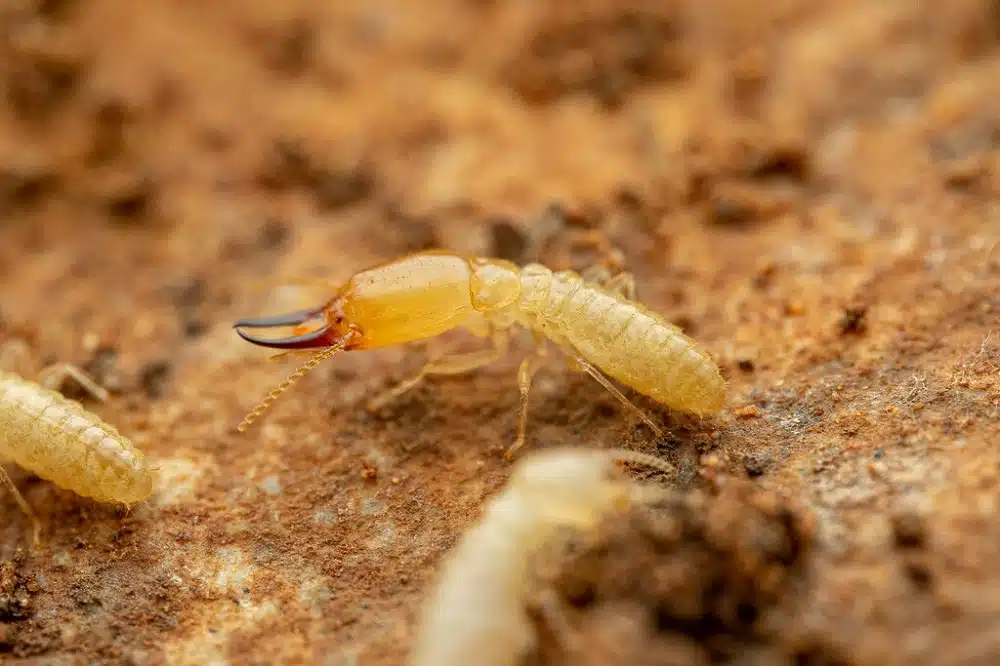
Termites often live in the desert. The Desert Subterranean Termite (Heterotermes aureus) is a species that’s prevalent in Arizona, with considerable presence in Mexico, and California.
These termites feed on desert cacti and whatever wood they can find.
Old wooden utility poles in the desert are the most likely to be damaged.
The species is identified by the veins on its wings and by the galleries it builds in wood, often with mud inside.
Desert Subterranean Termites can be active throughout the year, especially when it rains.
From July to early fall, these termites swarm and move quickly by flying.
Some of their ideal landing locations are moist areas of the desert where the female establishes a new colony.
26. Sonoran Desert Fly
A species identified by its elongated abdomen, The Sonoran Desert Fly (Drosophila mettleri) is a species that relies on cacti to live and breed.
Some of the tallest cacti in North America, such as saguaro and cardon are among its most common hosts.
This fly doesn’t settle and eat purely healthy cacti as it chooses the cacti with rotting patches it feeds on.
The type of cacti and the amount of necrotic tissue available to these flies influence their size and numbers within an area.
Interestingly, most species can’t feed on these cacti due to their toxins but Sonoran Desert Flies are resistant to their toxins.
These flies are also known for their vivid vibrations during the courting process which allows males to have better success in finding a female partner.
27. Citrus Cicada

Citrus Cicadas (Diceroprocta apache) emerge every year in the desert but show a cyclical lifespan.
Spending most of their lives in the ground, Citrus Cicadas are also known for taking even more than a decade to emerge from their larval stage.
This habit is believed to keep them safe in front of potential predators which simply die without any food.
While some cicadas emerge every year, most Citrus Cicadas only emerge within a few years, typically together with others.
A high number of cicadas that emerged each year also keeps their numbers safe as there are plenty of them even with many predators.
Some of the most common issues cicadas face is a high number of predators, including wasps.
Once believed to be a non-feeding species, Citrus Cicadas feed on tree and plant sap by sucking.
28. California Mantis

Unlike cicadas, California Mantises (Stagmomantis californica) live short lives of up to a year.
Females can live slightly longer, typically awaiting a good chance to lay eggs but not longer than 2 years as well.
Unlike Citrus Cicadas, California Mantises are actual predators.
They feed on all types of small insects they can overpower. They also eat the young of their species.
Since they grow up to 3 inches, California Mantises eat insects that are 2 inches or less.
These bugs are also nocturnal, an ideal time to move their area and avoid the high desert heat.
Mostly green or brown, California Mantises are growing in range and numbers.
They adapt to cooler winters and have expanded their range further North from their desert Southwestern US range.
29. African Mantis

African Mantises (Sphodromantis viridis) are some of the largest bugs of the Western Sahara.
Some of the largest bugs of this species measure as much as 3.9 inches and often eat large bugs as well.
Adaptable to their hot habitat, these types of praying mantises are predators. They feed on insects and have even been known to eat meat in captivity.
Also known as Bush Mantises, African Mantises live close to vegetation and wildflowers, areas known to attract other bugs and insects for them to pounce on.
These types of bugs are also resilient, able to go long periods without food or long periods of drought.
Some of the new climates the bugs are introduced in also include arid climates such as those of Southern Israel.
30. Giant Mesquite Bug

As their name implies, these large bugs (Thasus neocalifornicus) feed on mesquite. They prefer its seeds and often release chemicals to communicate to other bugs of their presence.
These bugs have a shield-shaped body and crimson-red legs.
Reaching a maximum length of 2 inches, these bugs are native to The Sonoran Desert and Baja California.
Much of their range is limited by their high numbers of predators given they can easily be spotted due to their size and red legs.
As they’re active during the night, they are often predated by nocturnal species such as bats.
Giant Mesquite Bugs have different defensive mechanisms such as emitting chemicals when a threat is detected.
This bug is short-lived, typically dying in the fall.
Its eggs are laid before late fall and they hatch in early spring or during the rainy season.
31. Masked Hunter

Masked Hunters (Reduvius personatus) are types of bugs found in various temperate climates and deserts.
This is a species that uses dust to cover its nymphs, a habit that inspires its name.
Masked Hunters may also bite when handled, particularly as adults.
The bite of these bugs is highly painful. The pain level in the area of the bite plus other symptoms such as swollen skin can persist for up to a week.
Masked Hunters are dark with an elongated body. You can separate stinging adults from non-stinging adults by their shiny elytra as the nymphs are covered in dust and sand.
Covering up in sand and dust is what allows the young Mask Hunter to reach adulthood by camouflaging itself.
They do this themselves by secreting a sticky substance sand adheres to.
32. Western Corsair

Western Corsairs (Rasahus thoracicus) also live in varied habitats, including the desert.
A base black color is specific to this species which shows contrasting orange stripes and marks across the body.
This type of bug feeds on various soft-bodied prey such as larvae and caterpillars.
It pierced its prey with a stinger to eat them. This is also a bug that can bite, typically resulting in high pain.
The painful bite symptoms the species is associated with can last up to a week.
Western Corsairs go through different life cycles before becoming an adult.
Their journey to adulthood takes about a year, longer than in other bugs.
In some areas with Western Corsairs, these bugs are considered pests as they feed on beneficial insects such as bees.
33. Creosote Bush Walkingstick
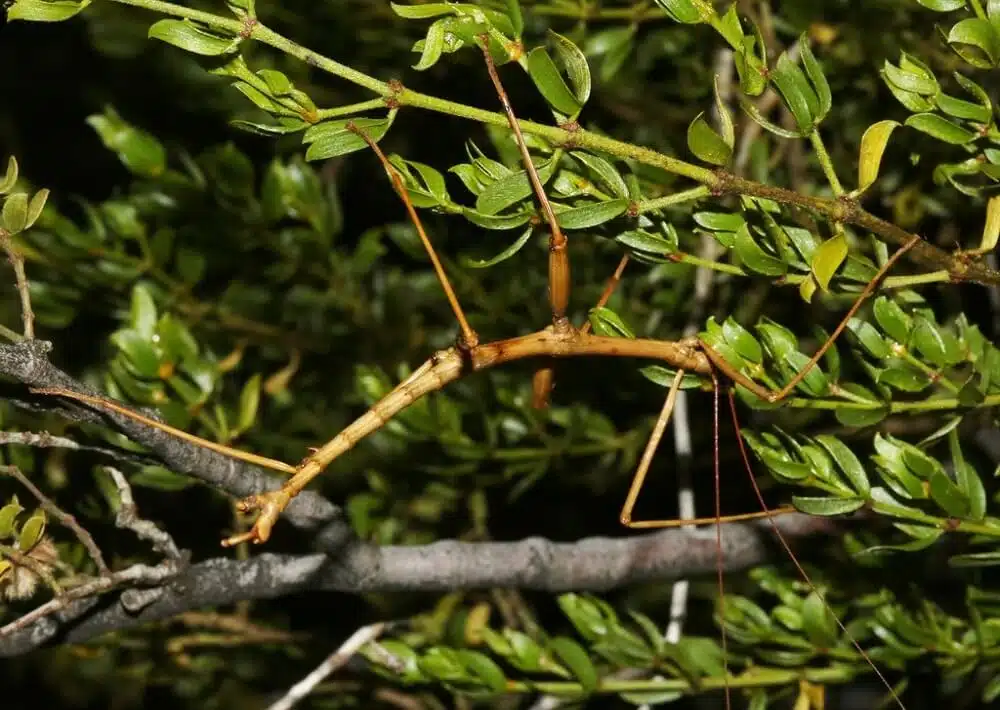
A species of dry and desert areas, Creseote Bush Walkingsticks (Diapheromera covilleae) have a stick-like appearance.
Despite their narrow bodies, these types of bugs have a long stature growing to a size of up to 3.9 inches in the case of males.
Female Creosote Bush Walkingsticks grow to a size of up to 1.7 inches with antennae as long or longer than their bodies.
Thin long antennae are also specific to this species.
Bugs of this family feed on various new leaves found on local plants.
Some of the best places to spot Creosote Bush Walkingsticks are around the cacti of The Sonoran Desert.
Spotting these bugs is not easy, still, as they only move about for food at night.
34. Desert Firefly
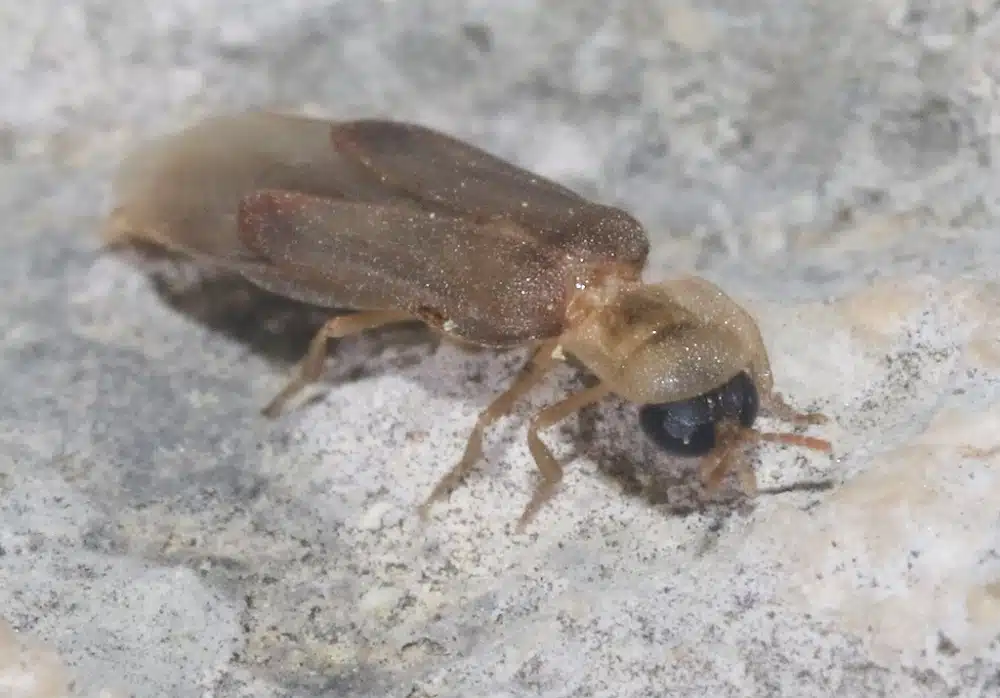
This type of bug (Microphotus octarthrus) is native to North America and can remotely be spotted in Southwestern Deserts.
Many of these bugs can fly and illuminate the sky at night but they might not be easy to spot since they don’t live close to populated areas.
A type of beetle, Desert Fireflies have a dark brown appearance with a yellow and also striped head.
35. Namibia Katydid

A specie endemic to The Namib Desert, The Namibia Katydid (Acanthoproctus diadematus) is among those bugs specific to the desert through food preferences.
It’s here that the bug feed only on an atypical type of melon, the nara melon.
A specific species of the desert, this is a melon that grows on a plant without any leaves which is covered in spines to adapt to the desert climate.
Namibia Katydids are identified by their brown nuances. A bright brown cephalothorax is specific to this bug which additionally shows a dark brown abdomen.
36. Arizona Bark Scorpion

Arizona Bark Scorpions (Centruroides sculpturatus) are commonly found in the deserts of the Southern US.
This is the most venomous type of scorpion in The United States, often requiring medical attention after being stung.
The species has potent venom and a painful sting which can remain highly painful for days in a row.
Avoiding it altogether is recommended as in some of the most severe cases, its sting can even lead to immobilization of the stung limb, shortness of breath, or blurred vision.
Arizona Bark Scorpions are among the multiple bright species of scorpions in the world. This species has a bright brown or even tan nuance.
Living in the desert, the species is also prey for various predators such as birds.
37. Deathstalker

Also known as The Palestine Yellow Scorpion, The Deathstalker (Leiurus quinquestriatus) is one of the deadliest scorpions in the world.
Living in the deserts of The Middle East and introduced to other areas of the world, this scorpion can kill a human with a single sting.
Groups at risk include those suffering from certain medical conditions, children, and seniors.
With a powerful mix of toxins, its venom is locally treated in hospitals with antivenom.
In the United States, there’s no approved antivenom at the moment due to its scarcity.
Some of the arid areas the scorpion lives that also lack an antivenin include East Africa.
38. Desert Grass Spider

A species of North America and Central America, The Desert Grass Spider (Agelenopsis aperta) is a species that builds spider webs.
This is a spider that builds funnel-shaped webs inside of its burrows where it can easily trap different insects.
A yellow-brown color with black legs is specific to its body while its legs are dark brown.
This spider is also one of the venomous species of US deserts. Its bite is painful and its effects can last for days.
39. Six-Eyed Sand Spider

A type of spider that resembles crabs and their spiders, Six-Eyed Sand Spiders (Sicarius thomisoides) look like the sand.
They have an earthy color and are almost impossible to distinguish on the ground.
As one of the largest species of the desert, Six-Eyed Sand Spiders are also known for eating large prey, including scorpions.
They rely on their strong venom to immobilize scorpions.
The bite of the species is known to be highly painful and leads to skin necrosis.
40. Arizona Desert Centipede
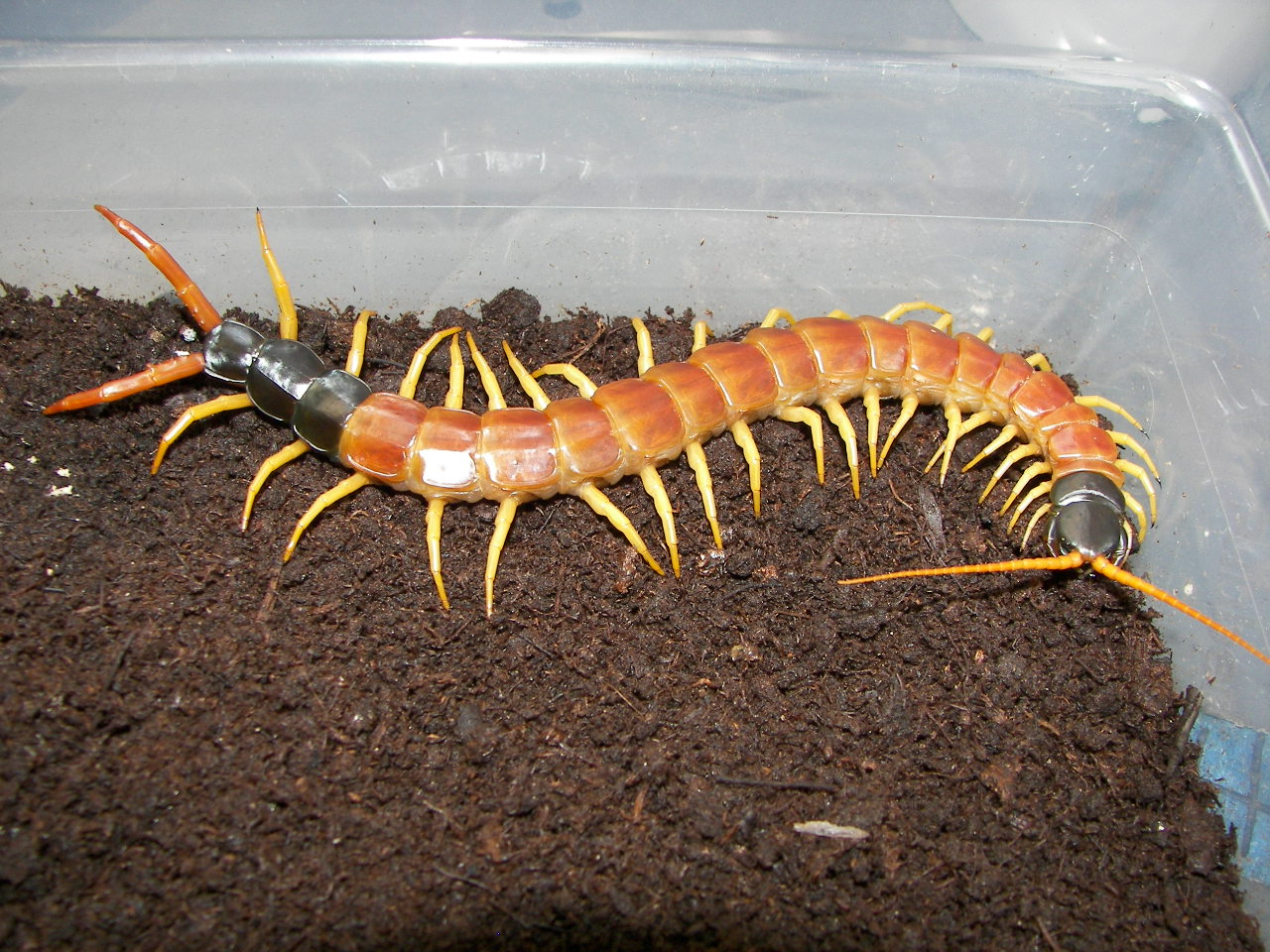
Also known as The Texas Redhead Centipede, The Arizona Desert Centipede (Scolopendra heros) is also venomous.
Its bite is painful with pain levels that can last hours or even days.
Growing to a size of up to 6.5 inches, The Arizona Desert Centipede is larger than The Six-Eyed Sand Spider.
It also eats larger prey and a large number of invertebrates.
A venomous species of the Southwestern deserts, Arizona Desert Centipedes can live up to 6 years.